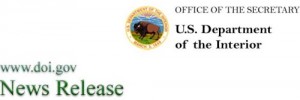 Date: June 29, 2015
Date: June 29, 2015
Contacts: Jessica Kershaw (DOI), Interior_Press@ios.doi.gov
Nedra Darling (ASIA), 202-219-4152
Initiative Reforms a Process Long Criticized as “Broken,” Increases Transparency in Important Review of Tribal Recognition Status
WASHINGTON – U.S. Secretary of the Interior Sally Jewell and Assistant Secretary-Indian Affairs Kevin K. Washburn today released a final rule to reform the regulatory process by which the Department of the Interior officially recognizes Indian tribes. The updated rule promotes a more transparent, timely and consistent process that is flexible enough to account for the unique histories of tribal communities, while maintaining the rigor and integrity of the criteria that have been in place for nearly 40 years.
“Since the beginning of President Obama’s Administration, the Department has worked with tribal and government leaders on improving the federal acknowledgment process, which has been criticized as inconsistent, slow and expensive,” Secretary Jewell said. “This Administration takes very seriously its important trust and treaty responsibilities to Native Americans and Alaska Natives. This updated process for important tribal recognition makes good on a promise to clarify, expedite and honor a meaningful process for federal acknowledgement to our First Americans.”
“This updated rule is the product of extraordinary input from tribal leaders, states, local governments and the public,” said Assistant Secretary Washburn. “We have a responsibility to recognize those tribes that have maintained their identity and self-governance despite previous federal policies expressly aimed at destroying tribes. This new process remains rigorous, but it promotes timely decision-making through expedited processes and increases transparency by posting all publically available petition materials online so that stakeholders are well-informed at each stage of the process. Many of these improvements came from public comments by stakeholders and we are grateful for their guidance.”
To maintain the substantive rigor and integrity of the current regulatory process (described in Part 83, Title 25 – Code of Federal Regulations), the final rule carries forward the current standard of proof and seven mandatory criteria that petitioners must meet to substantiate their claim to tribal identification, community and political authority. To promote fairness and consistent implementation, the new process provides that prior decisions, which found evidence or methodology sufficient to satisfy a particular criterion for a previous petitioner, are sufficient to satisfy that criterion for a present petitioner. The final rule further promotes consistent application by establishing a uniform evaluation period of more than a century, from 1900 to the present, to satisfy the seven mandatory criteria.
Key features of the final rule promote transparency by:
- Increasing public access to petition documents for Federal Acknowledgment;
- Expanding distribution of notices of petitions to include local governments; and
- Increasing due process by providing for an administrative judge to conduct a comprehensive hearing and issue a recommended decision for proposed negative findings.
In a separate action, Assistant Secretary Washburn issued a policy statement explaining that the Department intends to rely on the newly reformed Part 83 process as the sole administrative avenue for acknowledgment as a tribe as long as the new rule is in effect and being implemented.
To build public trust in the Federal Acknowledgement process, the Department has been working to reform the Part 83 process since the beginning of the Obama Administration. At that time in 2009, Interior initiated its own review. In 2012, the Department identified guiding principles of the reform effort. In recognition of the high level of interest, the Department used a transparent rulemaking approach and significant outreach effort. Before beginning the formal rulemaking initiative, Interior issued a discussion draft in 2013 to facilitate public input on how to improve the process.
Through the discussion draft and ensuing tribal consultations and public meetings, the Department obtained substantial feedback. In total, more than 2,800 commenters provided input on the discussion draft. The Department issued a proposed rule in May of 2014 and extended the public comment period on that proposal in response to requests from tribes, state and local governments, members of Congress and the public. In total, more than 330 unique comments were submitted on the proposed rule. The final rule reflects substantial changes to the discussion draft and the proposed rule in response to public comments.
Federal acknowledgment establishes the U.S. Government as the trustee for Tribal lands and resources and makes Tribal members and governments eligible for federal budget assistance and program services. Since 1978, of the 566 federally recognized tribes, 17 have been recognized through the Part 83 process under Title 25 of the Code of Federal Regulations, Procedures for Establishing that an American Indian Group Exists as an Indian Tribe. The Department has denied acknowledgment to 34 other petitioning groups.
Though far more tribes have been recognized through Executive or Congressional action, the Part 83 process is an important mechanism because it allows deliberative consideration of petitions by a staff of federal experts in anthropology, genealogy and history and ultimately allows for a decision by the Assistant Secretary-Indian Affairs. When petitioning groups that meet the criteria are officially “acknowledged” as Indian tribes, the U.S. Government accepts trusteeship of Tribal lands and natural resources. Tribal governments and members then become eligible to receive federal health, education, housing and other program and technical assistance.
The final rule and other information is online here.


